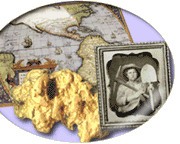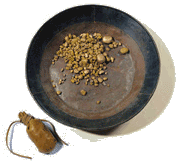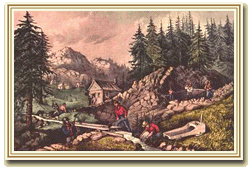

 |
 |

|
The lure of gold has fascinated mankind since antiquity. Many voyages to the New World and elsewhere, by Spanish, British, and other explorers, were in quest of gold. Wars have been fought, kingdoms have risen and fallen, and countries have been won and lost because of this precious yellow metal. No other substance has ever captured imagination and engendered fascination as gold has. At New Helvetia, California, in 1848, Captain John A. Sutter, a Swiss who had come to the state in 1839, managed a community of tens of thousands of acres centered around what was known as Sutter’s Fort. Seeking to create a source for lumber, which was fairly scarce in California at the time, Captain Sutter enlisted James Marshall and several others to explore sites for a sawmill along the American River, a fast-flowing waterway about fifty miles on horseback from the fort. After some consideration, a spot was selected at Coloma, and erection of the sawmill began. As the structure neared completion, Marshall and his associates sought to deepen the channel, or race, that diverted water from the river and drove the mill wheel. To do this, they dammed the top of the race, then opened it at night and let the water rush through to sweep out small rocks and gravel. Gold! What
happened next is subject to several versions, but in
essence, Marshall was looking at the water running through
the tail race on the morning of January 24, 1848, when he
saw a little golden sparkle, a yellow flash. He reached
down and extracted a small flake. It looked like gold! What
happened next is subject to several versions, but in
essence, Marshall was looking at the water running through
the tail race on the morning of January 24, 1848, when he
saw a little golden sparkle, a yellow flash. He reached
down and extracted a small flake. It looked like gold!
Marshall traveled back to the fort and asked for a private audience with Captain Sutter, where Marshall displayed some samples of the yellow substance he had found. Sutter took from the shelf a volume of an encyclopedia and performed several tests, including weighing and subjecting the metal to acid. It most certainly was gold. “Eureka!” Or “I have found it!” became the word of the day and, in 1849, was incorporated as the state motto. News SpreadsSeeking to have his sawmill completed, Sutter swore the workers to secrecy and asked them to not mention the matter for six weeks. However, the excitement of
gold could not be contained, and by spring a few hundred
men were at work up and down the American River. Soon just
about every able-bodied man had left San Francisco and
headed for the gold fields. Even the local newspaper was
forced to close down for lack of help and no readers. However, the excitement of
gold could not be contained, and by spring a few hundred
men were at work up and down the American River. Soon just
about every able-bodied man had left San Francisco and
headed for the gold fields. Even the local newspaper was
forced to close down for lack of help and no readers.
On December 5, 1848, in his annual message to Congress, President James Knox Polk stated that gold had been found in California, and in large quantities. Specimens were sent to the Philadelphia Mint for analysis, where the assayers found the metal to be of unbelievable quality. The Gold Rush was on. California ho! By the sea...In the early days, ocean travel was difficult. Facilities aboard ship were crowded, agents often sold more tickets than there were berths available,food was poor, and the vessels were often unsafe. As passenger traffic increased, the accommodations went from poor to miserable, except for those who paid a premium and secured one of the few first- or second-class cabins available.Many elected to go to California around the tip of South America, Cape Horn, continuing in the Pacific to San Francisco, nearly 15,000 miles and about 5 months in travel if the winds were good and nothing unforeseen occurred. Others sailed to the Isthmus of Panama, secured passage across the 60 miles of land, and then took their chances on finding another ship to take them from Panama to San Francisco, a much shorter trip, but one that involved the hazards of tropical disease and danger in the Panamanian forests. ...and by landThe most popular way to go to California was overland. The overland trip by ox-drawn wagon took about five months in the early days of the Gold Rush. The actual time varied, depending upon the route taken and the available equipment. Happy adventurers in high spirits formed wagon trains. Singing O Susanna and other rollicking melodies, they headed westward, with each night’s stop being an occasion for festivities and celebration—at least at the start of the trip. They experienced many
hardships, including the plague of cholera which may have
carried off as many as three or four thousand of
the Arriving in CaliforniaBy the late spring of 1849, those who had come by sea and the Panama shortcut arrived in San Francisco, which became a “calico city,” full of tents and improvised structures.Immigrants coming to California by land or sea brought pans, shovels, containers for gold, contraptions for processing gold, etc., but few thought to bring much in the way of money. Thus, by the summer of 1849 there were tens of thousands of newcomers in California, but not enough coins to go around. Trade was conducted in gold dust, such as a “ pinch” as payment for a saloon libation. Gold coins and ingotsThe shortage of coins continued throughout 1849 and 1850 and was filled in part by private minters and assayers, including Moffat & Company and F.D. Kohler, both of whom made rectangular gold ingots or bars.
Shipment of treasureAs gold poured forth from the rivers, streams and hills of California, it was shipped to San Francisco, and from there to distant points, most notably New York City and London. Much of the treasure sent to New York was conveyed to the Philadelphia Mint and converted into coins. Tens of millions of dollars in gold ingots, coins, and sometimes nuggets and particles were shipped each year.Mints in CaliforniaBeginning in 1849, and continuing into the early 1850s, several private coining firms set up business in California, including Moffat & Company, which was joined
Moffat implemented a contract with the federal government in 1851 to found what became known as the U.S. Assay Office of Gold, with August Humbert, New York City watchmaker of excellent reputation, employed under the title U. S. Assayer of Gold. Beginning in 1851, impressive, large, eight-sided gold “slugs,” often called adobes (for adobe “bricks” used in construction), were made in quantity, affording a convenient way to transport gold from place to place. In addition, rectangular ingots were made for larger transactions and export. In 1854 the San Francisco Mint opened, using facilities formerly occupied by the U.S. Assay Office of Gold. During the first year, gold coins were struck there of the $1, $2.50, $5, $10, and $20 denominations. The highest value coin, the double eagle, became the denomination of choice—as it was the largest regular federal piece issued. Golden double eagles were strictly utilitarian, and after they were placed into circulation they soon became scattered, worn, damaged, or lost. So far as is known, not a single numismatist saved an example of a Mint State double eagle in the 1850s. The Mint Cabinet at the Philadelphia Mint, which had been set up in June 1838 to display the nation’s coinage, received one striking of the first double eagle, an 1854-S, but did not have such
It took a while for the San Francisco Mint to become fully operational, and until 1855 private minters still flourished. In later years, such firms as Kellogg & Company and Wass, Molitor & Company were active and produced mainly $20 pieces, although Wass, Molitor made some impressive $50 coins. After 1855 there was no private coinage in San Francisco.
|
||||||||